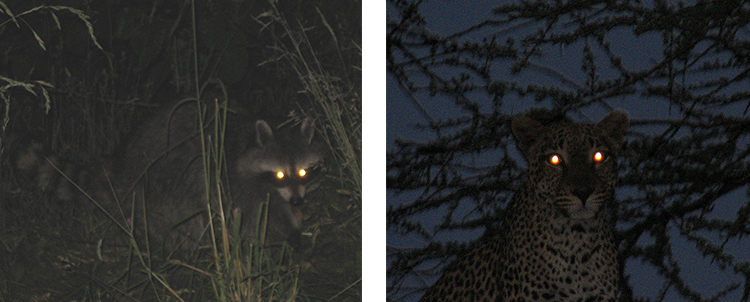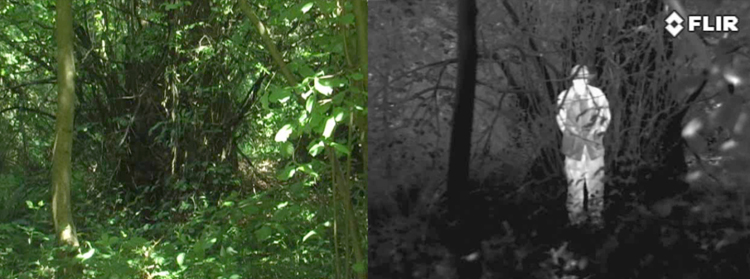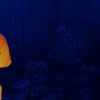Seeing the Unseen – What Your Eyes Can’t Show You
Life at night is an entirely different world, a unique environment as peculiar as the bottom of the sea, and as foreign as the surface of the moon. For thousands of years people have been trapped by the range of visible light that the human eye absorbs, a relatively small spectral range that leaves a great deal unseen and subject to our active imagination. That is no longer the case.
The reason night vision has been a historic weakness for Homo sapiens is due to our biological deficiency regarding the ‘tapetum lucidum’ – a layer of tissue that many other animals, such as our cats and dogs have. The reflective characteristics of this layer enhance the visible light available to these animals, providing a second chance for the capture of visual pigments when natural light is low or non-existent. This is a key factor in your cat’s uncanny ability to be noisy and rambunctious at 4:28 in the morning. Another biological success story are snakes belonging to the pit viper family, they have sensory “pits” which allow them to detect warm blooded animals even in the pitch black– a terrifying thought for anyone who may not be overly fond of the scaly reptiles.

Overcoming Evolution
In the span of less than a century we’ve overcome evolutionary processes that took millions of years to develop for other species and made them exceptionally functional. By understanding electromagnetic radiation (that’s a scientific way of saying light) we’ve developed unique solutions to mimic nature for varying purposes. Solutions target near-infrared, and infrared (NIR & IR) wavelengths, with NIR covering wavelengths between 0.7-1.3 microns, and IR extending from 1.4 to 15. IR can be broken down into short, mid, and long. Long wave infrared is commonly described as ‘thermal’, and likely something you’ve seen before! Both long wave IR and NIR have an incredibly diverse application range.

Perhaps you’re starting to see why this technology opens up a new realm of possibilities for human activity. Did you know the man was in the bushes? Could you tell how many mountain peaks there were? These are images taken during the day, where visible light is available to us. The difference is even starker when you take that away, highlighting the frustrating limitations of human physiology.

From your backyard to the Gulf of Aden, enhancement of the human capacity for low or no visibility situations has become increasingly paramount to success in a plethora of applications. Night vision tools are used extensively in some of the most hostile, challenging, and unforgiving human scenarios. Somalia pirates were responsible for over $6.6 billion worth of damages to international trade in 2011 – most of their hijackings occurring in the early morning and on moonlit nights, times with fog, mist or weak visibility. The World Wildlife Fund estimates that illegal wildlife trade was worth $19 billion in 2012, with many poachers operating under the cover of darkness. The military uses this technology extensively in defensive operations and applications – it even had a hand in locating Osama Bin Laden.
The vast majority of us will not need to see in these situations, but NIR and IR still have a prominent place in the possibilities of our lives. Fog and low visibility are responsible for almost 40,000 car accidents yearly in the United States. In 2012 there were over 10,000 search and rescue incidents in Canada – occurring in dense forests, low visibility weather, and initiated from aircraft at high altitudes. Maybe your vegetable patch has been ravaged during the summer, or your garbage devoured by an unidentified suspect; maybe you wonder who or what is wandering through your yard in the dark of the night? NIR and IR have a place even in these familiar locales.
Infrared Technologies have a growing place in our world, from the exciting to the mundane of our lives. The technology improves every day, with Teledyne Dalsa at the forefront of an immensely exciting frontier. Hunting poachers? Disrupting pirates? Rescuing parties in distress? The possibilities are phenomenal, the applications endless, and the future uncertain, but we will continue to provide technology to enhance people’s lives, and to better the world we live in.
For more about our NIR and IR capabilities – TeledyneDalsa.com.



 Dark Busters: Revealing Hidden Threats with Uncooled IR Detectors
Dark Busters: Revealing Hidden Threats with Uncooled IR Detectors  A First Blueprint for Machine Vision: Look, Record, then Perfect
A First Blueprint for Machine Vision: Look, Record, then Perfect 